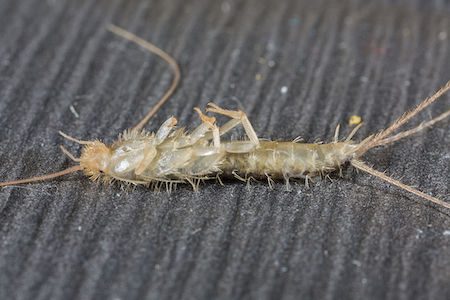Why Do Silverfish Love Your Kitchen (and Bathroom)?

Did you know that silverfish are not only widespread across nearly every continent but also active at all times of the year? Silverfish are a stubborn and numerous pest that can seek out the warm, humid areas of your home with ease. Silverfish infestation carries many issues, making them vital for homeowners to avoid.
COMPARE PRICESIf you’ve been struggling with such a nuisance, we’re here to help. Here’s a brief guide on silverfish, what attracts them, and how you can get them under control.
What Are Silverfish?
To start with, silverfish are a small insect pest that makes their way into your home. These wingless insects are typically no more than 19 millimeters long with six legs and two long antennae.
One easy way to identify them past their coloration and length is their “tails.” These pests are often called bristletails due to three bristles at the end of their body.
Silverfish are also nocturnal, meaning that you’ll almost always see them at night. If you’re early to bed and early to rise, you could go weeks or even months without seeing them during the day. Oftentimes, seeing them during the day means that the infestation is much more severe.
One good thing about silverfish is that, as insects themselves, they’re completely harmless. Silverfish cannot bite or sting you in any way and will almost always run from you, similar to roaches. However, an infestation will bring many other issues that will harm your health.
What Attracts Silverfish?
Silverfish feed on many sources, all of which are common issues that will attract them. Primarily, they eat sugar and starch from household items. You can find them eating pages, documents, wallpaper, books, and many other papery substances.
These pests also feed on soap, hair, dandruff, and dust particles as sustenance. You can even find them eating other silverfish. Coffee, sugar, oats, and beef products are other favorites of these pests.
Past these food sources, silverfish are also attracted to warmth and humidity. Preferring warm, humid, dark areas as well as dandruff and hair means that these pests are extremely common in the bathroom. You also are likely to find them in the kitchen due to the concentration of food.
Negative Effects of Silverfish
One of the primary issues with silverfish is that they will contaminate your food. Due to their taste for meat, flour, oats, and sugar, it’s common to find them in or around these items. If found around these items, you should immediately discard them to avoid sickness or parasites that silverfish may spread.
Another intense risk is that silverfish breed rapidly and multiply almost overnight. Because of this, infestations occur easily and swiftly, rising exponentially. Ensure that you’re dealing with a silverfish infestation immediately to handle this.
Silverfish also cause severe damage to homes and property similar to termites. While they won’t cause quite as severe a problem as termites will, they can ruin walls, wallpaper, wooden flooring, and more.
Finally, silverfish also can irritate allergies and cause respiratory complications. Silverfish shed tropomyosin, a protein that can combine with other allergens. When this combination occurs, it can cause allergic reactions in some individuals.
Tropomyosin isn’t the only allergen that silverfish shed, either. Their droppings can also cause allergic reactions to some.
How to Spot Silverfish
Silverfish infestations can be somewhat difficult to spot, especially if you’re asleep before nighttime. Due to their timid nature, they’ll rarely venture out past their nest before sunset or in any room with the light on.
Their droppings are a surefire sign, especially if found in piles. These droppings are tiny black pellets that you will often find around their nests or entry points.
Yellow stains and scaling in the area where the infestation is occurring are both common as well. Holes and scratches in items they might be digging into, such as containers of oats, will appear. If you notice any of these signs, consider having a nuisance pest expert come to diagnose the infestation and deal with it accordingly.
How to Handle
There are a number of ways to get rid of a silverfish infestation. Here are some of the most common methods of fixing the problem.
Chemical Bait
The use of chemical baits can lure and trap silverfish, killing them quickly. Unfortunately, silverfish are picky, and many commercial baits don’t work. Further exacerbating the issue is that silverfish can survive without eating or drinking, meaning they’ll rarely go for bait out of hunger as a mouse would.
Insecticides and pesticides are only truly useful for large infestations. When using such methods, you’ll need to get rid of any possible habitats that the silverfish may flee to. Ensure that you’re following safety instructions on any chemicals
Natural Solutions
If you’d like to avoid chemicals, there are more natural methods instead. The use of cedar shavings and oil is effective in repelling silverfish. Cinnamon, cloves, and diatomaceous earth are also both effective.
Mostly, these will repel or kill silverfish. They’re effective in prevention, but likely won’t make the cut if dealing with a full infestation.
Professional Help
When in doubt, never hesitate to call in professionals to help. Diagnosing an infestation can be difficult, to begin with, but handling it is sometimes much too complex for the average homeowner.
Nuisance pest exterminators will have the equipment and knowledge needed to deal with your silverfish infestation. A professional will work as effectively and quickly as possible.
Dealing with Silverfish Infestation
Silverfish are an awful pest to deal with but don’t be afraid if you catch them in your bathroom and kitchen. With proper preparation and prevention, you can stop a silverfish infestation from setting in. When in doubt, call a professional to deal with the problem for you.
If you have more questions about nuisance pest control, you can compare quotes here. You can also browse our extensive website for more information.
COMPARE PRICES
Leave a Reply